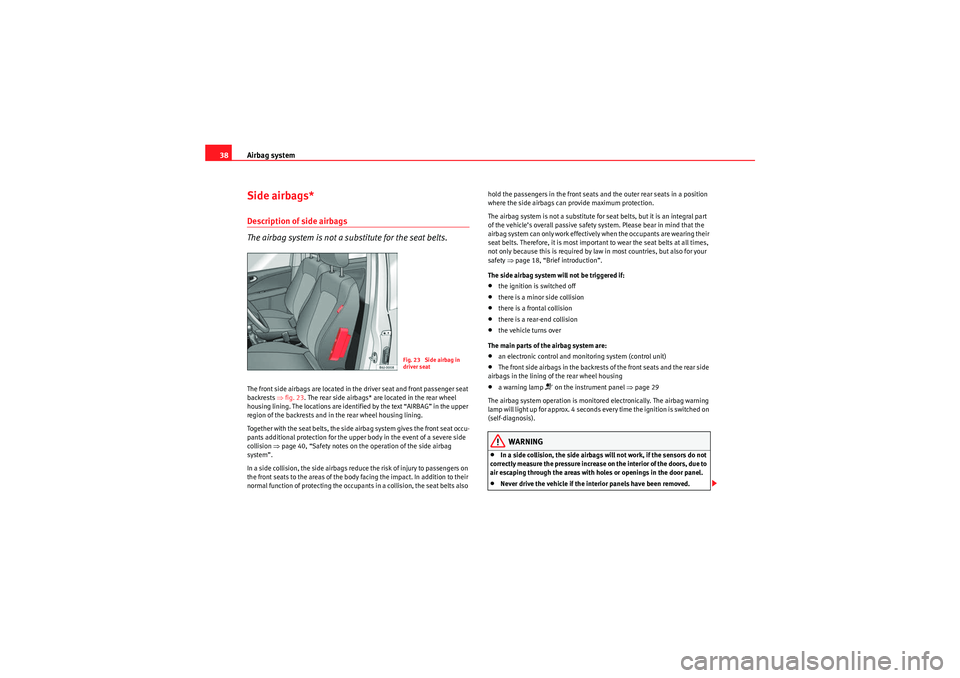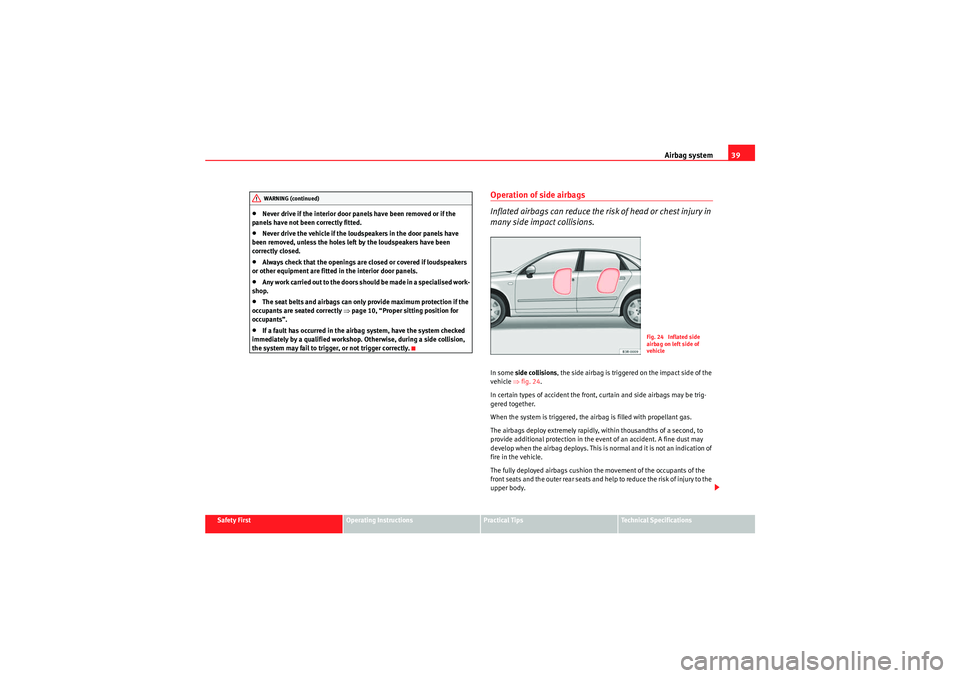remove seats Seat Exeo 2010 Owner's manual
[x] Cancel search | Manufacturer: SEAT, Model Year: 2010, Model line: Exeo, Model: Seat Exeo 2010Pages: 319, PDF Size: 9.64 MB
Page 29 of 319

Seat belts27
Safety First
Operating Instructions
Practical Tips
Technical Specifications
with these regulations and will be pleased to pass on the information to
you.
Service and disposal of belt tensionersThe belt tensioners are components of the seat belts that are installed in the
seats of your vehicle. If you work on the belt tensioners or remove and install
parts of the system when performing other repair work, the seat belt may be
damaged. The consequence may be that, in the event of an accident, the belt
tensioners function incorrectly or not at all.
So that the effectiveness of the seat belt tensioner is not reduced and that
removed parts do not cause any injuries or environmental pollution, regula-
tions, which are known to the specialised workshops, must be observed.
WARNING
•Improper use or repairs not carried out by qualified mechanics increase
the risk of severe or fatal injuries. The belt tensioners may fail to trigger or
may trigger in the wrong circumstances.•Never attempt to repair, adjust, remove or install parts of the belt
tensioners or seat belts.•The seat belt tensioner, seat belt and automatic retractor cannot be
repaired.•Any work on the belt tensioners and seat belts, including the removal
and refitting of system parts in conjunction with other repair work, must be
performed by a qualified workshop only.•The belt tensioners will only provide protection for one accident and
must be changed if they have been activated.
exeo_EN.book Seite 27 Montag, 30. August 2010 4:45 16
Page 40 of 319

Airbag system
38Side airbags*Description of side airbags
The airbag system is not a substitute for the seat belts.The front side airbags are located in the driver seat and front passenger seat
backrests ⇒fig. 23 . The rear side airbags* are located in the rear wheel
housing lining. The locations are identified by the text “AIRBAG” in the upper
region of the backrests and in the rear wheel housing lining.
Together with the seat belts, the side airbag system gives the front seat occu-
pants additional protection for the upper body in the event of a severe side
collision ⇒ page 40, “Safety notes on the operation of the side airbag
system”.
In a side collision, the side airbags reduce the risk of injury to passengers on
the front seats to the areas of the body facing the impact. In addition to their
normal function of protecting the occupants in a collision, the seat belts also hold the passengers in the front seats and the outer rear seats in a position
where the side airbags can provide maximum protection.
The airbag system is not a substitute for seat belts, but it is an integral part
of the vehicle’s overall passive safety system. Please bear in mind that the
airbag system can only work effectively when the occupants are wearing their
seat belts. Therefore, it is most important to wear the seat belts at all times,
not only because this is required by law in most countries, but also for your
safety
⇒page 18, “Brief introduction”.
The side airbag system will not be triggered if:
•the ignition is switched off•there is a minor side collision•there is a frontal collision•there is a rear-end collision•the vehicle turns over
The main parts of the airbag system are:•an electronic control and monitoring system (control unit)•The front side airbags in the backrests of the front seats and the rear side
airbags in the lining of the rear wheel housing•a warning lamp
�T on the instrument panel ⇒page 29
The airbag system operation is monitored electronically. The airbag warning
lamp will light up for approx. 4 seconds every time the ignition is switched on
(self-diagnosis).
WARNING
•In a side collision, the side airbags will not work, if the sensors do not
correctly measure the pressure increase on the interior of the doors, due to
air escaping through the areas with holes or openings in the door panel.•Never drive the vehicle if the interior panels have been removed.
Fig. 23 Side airbag in
driver seat
exeo_EN.book Seite 38 Montag, 30. August 2010 4:45 16
Page 41 of 319

Airbag system39
Safety First
Operating Instructions
Practical Tips
Technical Specifications
•Never drive if the interior door panels have been removed or if the
panels have not been correctly fitted.•Never drive the vehicle if the loudspeakers in the door panels have
been removed, unless the holes left by the loudspeakers have been
correctly closed.•Always check that the openings are closed or covered if loudspeakers
or other equipment are fitted in the interior door panels.•Any work carried out to the doors should be made in a specialised work-
shop.•The seat belts and airbags can only provide maximum protection if the
occupants are seated correctly ⇒page 10, “Proper sitting position for
occupants”.•If a fault has occurred in the airbag system, have the system checked
immediately by a qualified workshop. Otherwise, during a side collision,
the system may fail to trigger, or not trigger correctly.
Operation of side airbags
Inflated airbags can reduce the risk of head or chest injury in
many side impact collisions.In some side collisions , the side airbag is triggered on the impact side of the
vehicle ⇒fig. 24 .
In certain types of accident the front, curtain and side airbags may be trig-
gered together.
When the system is triggered, the airbag is filled with propellant gas.
The airbags deploy extremely rapidly, within thousandths of a second, to
provide additional protection in the event of an accident. A fine dust may
develop when the airbag deploys. This is normal and it is not an indication of
fire in the vehicle.
The fully deployed airbags cushion the movement of the occupants of the
front seats and the outer rear seats and help to reduce the risk of injury to the
upper body.
WARNING (continued)
Fig. 24 Inflated side
airbag on left side of
vehicle
exeo_EN.book Seite 39 Montag, 30. August 2010 4:45 16